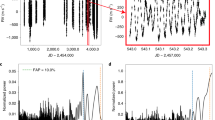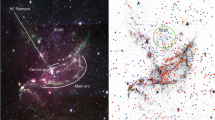Abstract
β Pictoris (β Pic) is a main-sequence star with an edge-on dust disk1,2,3 that might represent a state of the early Solar System. The dust does not seem to be a remnant from the original protoplanetary disk, but rather is thought to have been generated from large bodies like planetesimals and/or comets4,5. The history and composition of the parent bodies can therefore be revealed by determining the spatial distribution, grain size, composition and crystallinity of the dust through high-resolution mid-infrared observations. Here we report that the sub-micrometre amorphous silicate grains around β Pic have peaks in their distribution around 6, 16 and 30 au (1 au is the Sun–Earth distance), whereas the crystalline and micrometre-sized amorphous silicate grains are concentrated in the disk centre. As sub-micrometre grains are blown quickly out from the system by radiation pressure from the central star, the peaks indicate the locations of ongoing dust replenishment, which originates from ring-like distributions of planetesimals or ‘planetesimal belts’.
This is a preview of subscription content, access via your institution
Access options
Subscribe to this journal
Receive 51 print issues and online access
$199.00 per year
only $3.90 per issue
Buy this article
- Purchase on Springer Link
- Instant access to full article PDF
Prices may be subject to local taxes which are calculated during checkout



Similar content being viewed by others
References
Gillett, F. C. in Light on Dark Matter (ed. Israel, F. P.) 61–69 (Reidel, Dordrecht, 1986)
Smith, B. A. & Terrile, R. J. A circumstellar disk around Beta Pictoris. Science 226, 1421–1424 (1984)
Pantin, E., Lagage, P. O. & Artymowicz, P. Mid-infrared images and models of the beta Pictoris dust disk. Astron. Astrophys. 327, 1123–1136 (1997)
Backman, D. E. & Paresce, F. in Protostars and Planets III (eds Levy, E. H. & Lunine, J. I.) 1253–1304 (Univ. Arizona Press, Tucson, 1993)
Lecavelier des Etangs, A., Vidal-Madjar, A. & Ferlet, R. Dust distribution in disks supplied by small bodies: is the β Pictoris disk a gigantic multi-cometary tail? Astron. Astrophys. 307, 542–550 (1996)
Crifo, F., Vidal-Madjar, A., Lallement, R., Ferlet, R. & Gerbaldi, M. β Pictoris revisited by Hipparcos. Star properties. Astron. Astrophys. 320, L29–L32 (1997)
Barrado y Navascues, D., Stauffer, J. R., Song, I. & Caillault, J.-P. The age of beta Pictoris. Astrophys. J. 520, L123–L126 (1999)
Wahhaj, Z. et al. The inner rings of β Pictoris. Astrophys. J. 584, L27–L31 (2003)
Malfait, K. et al. The spectrum of the young star HD100546 observed with the Infrared Space Observatory. Astron. Astrophys. 332, L25–L28 (1998)
Honda, M. et al. Detection of crystalline silicates around T Tauri star Hen3–600A. Astrophys. J. 585, L59–L63 (2003)
Campins, H. & Ryan, E. V. The identification of crystalline olivine in cometary silicates. Astrophys. J. 341, 1059–1066 (1989)
Knacke, R. F. et al. The silicates in the disk of beta Pictoris. Astrophys. J. 418, 440–450 (1993)
Hallenbeck, S. L., Nuth, J. A. III & Nelson, R. N. Evolving optical properties of annealing silicate grains: from amorphous condensate to crystalline mineral. Astrophys. J. 535, 247–255 (2000)
Kataza, H. et al. COMICS: the cooled mid-infrared camera and spectrometer for the Subaru telescope. Proc. SPIE 4008, 1144–1152 (2000)
Okamoto, Y. K. et al. Improved performances and capabilities of the Cooled Mid-Infrared Camera and Spectrometer (COMICS) for the Subaru Telescope. Proc. SPIE 4841, 169–180 (2003)
Sako, S. et al. Improvements in operating the Raytheon 320x240 pixel Si:As impurity band conduction mid-infrared array. Publ. Astron. Soc. Pacif. 115, 1407–1418 (2003)
Koike, C. et al. Compositional dependence of infrared absorption spectra of crystalline silicate II. Natural and synthetic olivines. Astron. Astrophys. 399, 1101–1107 (2003)
Dorschner, J., Begemann, B., Henning, Th., Jäger, C. & Mutschke, H. Steps toward interstellar silicate mineralogy. II. Study of Mg-Fe-silicate glasses of variable composition. Astron. Astrophys. 300, 503–520 (1995)
Artymowicz, P. Radiation pressure forces on particles in the Beta Pictoris system. Astrophys. J. 335, L79–L82 (1988)
Mukai, T. & Giese, R. H. Modification of the spatial distribution of interplanetary dust grains by Lorentz forces. Astron. Astrophys. 131, 355–363 (1984)
Fabian, D., Jäger, C., Henning, Th., Dorschner, J. & Mutschke, H. Steps toward interstellar silicate mineralogy V. Thermal evolution of amorphous magnesium silicates and silica. Astron. Astrophys. 364, 282–292 (2000)
Pantin, E., Waelkens, C. & Malfait, K. The Universe as Seen by ISO (eds Cox, P. & Kessler, M. F.) 385–388 (ESA SP 427, ESA Publications Division, Noordwijk, 1999)
Fixsen, D. J. & Dwek, E. The zodiacal emission spectrum as determined by COBE and its implications. Astrophys. J. 578, 1009–1014 (2002)
Backman, D. E., Witteborn, F. C. & Gillett, F. C. Infrared observations and thermal models of the Beta Pictoris disk. Astrophys. J. 385, 670–679 (1992)
Weinberger, A. J., Becklin, E. E. & Zuckerman, B. The first spatially resolved mid-infrared spectroscopy of β Pictoris. Astrophys. J. 584, L33–L37 (2003)
Acknowledgements
This Letter is based on data collected at the Subaru Telescope, which is operated by the National Astronomical Observatory of Japan. We thank C. Koike, I. Yamamura, F. Usui, S. Hasegawa, T. Ootsubo, H. Chihara, T. Nakamoto, H. Tanaka and T. Takeuchi for comments and discussions.
Author information
Authors and Affiliations
Corresponding author
Ethics declarations
Competing interests
The authors declare that they have no competing financial interests.
Rights and permissions
About this article
Cite this article
Okamoto, Y., Kataza, H., Honda, M. et al. An early extrasolar planetary system revealed by planetesimal belts in β Pictoris. Nature 431, 660–663 (2004). https://doi.org/10.1038/nature02948
Received:
Accepted:
Issue Date:
DOI: https://doi.org/10.1038/nature02948
This article is cited by
-
Evidence for an additional planet in the β Pictoris system
Nature Astronomy (2019)
-
Five steps in the evolution from protoplanetary to debris disk
Astrophysics and Space Science (2015)
-
Two families of exocomets in the β Pictoris system
Nature (2014)
-
Analysis of the Chemical Composition of the Atmospheres of Stars with Debris Disks and Planetary Systems
Astrophysics (2013)
-
Comet-like mineralogy of olivine crystals in an extrasolar proto-Kuiper belt
Nature (2012)
Comments
By submitting a comment you agree to abide by our Terms and Community Guidelines. If you find something abusive or that does not comply with our terms or guidelines please flag it as inappropriate.



